Historical Context of Art Nouveau
Art Nouveau, which translates to “New Art” in French, was an artistic movement that emerged in the late 19th century and peaked around the turn of the 20th century. It was a reaction against the academic art, eclecticism, and historicism of the 19th century, characterized by its organic forms, flowing lines, and intricate designs. The movement influenced various fields, including architecture, interior design, graphic arts, and decorative arts, with its proponents seeking to create a harmonious and unified environment.
The roots of Art Nouveau can be traced back to the Arts and Crafts Movement in England, which emphasized craftsmanship and the beauty of natural forms. However, Art Nouveau artists and designers took these principles further, incorporating sinuous lines and natural motifs such as flowers, leaves, and vines into their work. This approach resulted in a distinctive aesthetic that was both modern and timeless.
In architecture and interior design, Art Nouveau manifested in the use of curved lines, asymmetrical shapes, and the integration of decorative elements into the structural design. This was a departure from the rigid forms and classical motifs that had dominated previous architectural styles. The movement aimed to break down the boundaries between fine and applied arts, elevating everyday objects to the level of art.

Fireplace surrounds were a significant element of Art Nouveau interior design. These surrounds often featured elaborate carvings, tiles, and metalwork that incorporated the movement’s characteristic motifs. They served as focal points in rooms, exemplifying the fusion of form and function that was central to Art Nouveau philosophy.
Prominent figures in the Art Nouveau movement included architects and designers such as Victor Horta, Hector Guimard, Antoni Gaudí, and Charles Rennie Mackintosh. Each of these artists brought their unique interpretation to the style, contributing to its rich diversity and global influence. Their works remain celebrated examples of how Art Nouveau transformed spaces into works of art.
Understanding the historical context of Art Nouveau is essential for appreciating the significance and beauty of fireplace surrounds from this period. These pieces not only reflect the aesthetic ideals of the time but also represent a broader cultural shift towards integrating art into everyday life.

Key Characteristics of Art Nouveau Design
Art Nouveau design is distinguished by several key characteristics that set it apart from other styles. These features are evident in various forms of art and design, including architecture, furniture, jewelry, and, notably, fireplace surrounds. Understanding these characteristics can help one appreciate the unique beauty and craftsmanship of Art Nouveau fireplace surrounds.
One of the most recognizable features of Art Nouveau is its emphasis on organic forms and natural motifs. Designers drew inspiration from the natural world, incorporating elements such as flowers, leaves, vines, and flowing water into their work. This resulted in designs that are fluid and dynamic, often appearing to be in motion.
Curvilinear lines are another hallmark of Art Nouveau design. Unlike the straight, rigid lines of classical and neoclassical styles, Art Nouveau embraces curves and swirls. These lines can be seen in the intricate woodwork, metalwork, and ceramic tiles that adorn fireplace surrounds. The use of curves adds a sense of elegance and movement, making each piece visually engaging.
Asymmetry is also a significant characteristic of Art Nouveau. Rather than adhering to symmetrical and balanced compositions, designers often favored asymmetrical arrangements that create a more natural and organic feel. This approach can be seen in the placement of decorative elements on fireplace surrounds, where one side may differ slightly from the other, enhancing the sense of spontaneity and uniqueness.
The integration of different materials is another notable aspect of Art Nouveau design. Fireplace surrounds from this period often combine wood, metal, glass, and ceramics, showcasing the versatility and creativity of the artisans. The harmonious blending of these materials contributes to the overall aesthetic and tactile richness of the pieces.
Attention to detail and craftsmanship is a defining feature of Art Nouveau. Each element, no matter how small, is carefully designed and executed. This meticulous approach results in fireplace surrounds that are not only beautiful to look at but also finely crafted, with each component contributing to the overall harmony of the design.
Finally, Art Nouveau design often includes symbolic and allegorical elements. Designers imbued their work with deeper meanings, drawing on mythology, literature, and the natural world to create pieces that are both decorative and meaningful. This symbolic richness adds another layer of interest and complexity to Art Nouveau fireplace surrounds.

Materials and Techniques
Art Nouveau fireplace surrounds are renowned for their use of diverse materials and innovative techniques. These elements combine to create pieces that are not only visually stunning but also exemplify the high level of craftsmanship that defines the Art Nouveau movement. Understanding the materials and techniques used can provide insight into the complexity and artistry of these fireplace surrounds.
Wood was a popular material in Art Nouveau fireplace surrounds, valued for its warmth and versatility. Artisans used various types of wood, such as oak, walnut, and mahogany, to create intricate carvings and detailed inlays. The natural grain of the wood often added to the organic feel of the designs, complementing the movement’s emphasis on nature.
Metalwork also played a crucial role in Art Nouveau fireplace surrounds. Metals such as bronze, copper, and wrought iron were used to create decorative elements, including grilles, andirons, and surrounds. Techniques like repoussé (hammering the metal from the reverse side to create a design in low relief) and chasing (refining the design on the front side) were commonly employed to add texture and detail. The use of metal allowed for the incorporation of delicate, sinuous lines and intricate patterns that are characteristic of Art Nouveau.
Ceramics and tiles were frequently used to embellish Art Nouveau fireplace surrounds. Glazed tiles featuring floral and geometric patterns added color and visual interest. The use of ceramics allowed for vibrant and durable surfaces that could withstand the heat of the fire. Techniques such as slip casting (pouring liquid clay into molds) and hand painting were used to create the detailed designs typical of the period.
Glass was another important material in Art Nouveau design. Stained glass and leaded glass panels were often incorporated into fireplace surrounds, adding a touch of color and light. The use of glass also allowed for the creation of intricate, flowing designs that complemented the organic forms of the movement. Techniques like etching and sandblasting were used to add further detail to glass elements.
Stone and marble were also used in Art Nouveau fireplace surrounds, particularly for the mantel and hearth. These materials provided a solid and elegant foundation, often featuring carved details that echoed the natural motifs of the movement. Marble, with its range of colors and veining patterns, added a luxurious touch to the overall design.
Innovative techniques such as marquetry (the art of applying pieces of veneer to create decorative patterns) and mosaic work were also employed to enhance the beauty and intricacy of Art Nouveau fireplace surrounds. These techniques allowed for the creation of detailed and colorful designs that added to the overall aesthetic richness.
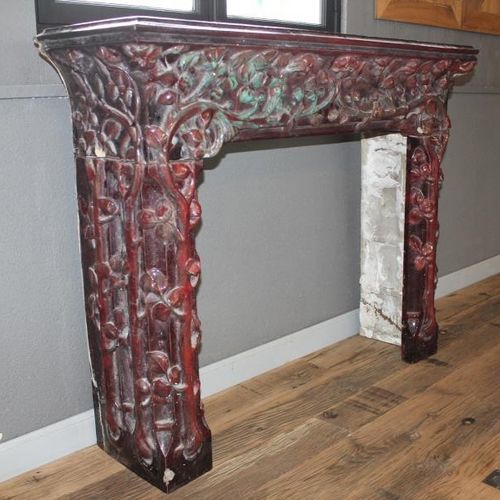
Prominent Designers and Their Influence
The Art Nouveau movement was marked by the contributions of several prominent designers and architects, whose work has left a lasting impact on the field of decorative arts. Their innovative designs and attention to detail helped to define the aesthetic of the period and continue to influence contemporary design. Understanding the contributions of these designers can provide a deeper appreciation for Art Nouveau fireplace surrounds.
Victor Horta, a Belgian architect, is often considered one of the pioneers of Art Nouveau. His work, characterized by its organic forms and intricate detailing, set the standard for the movement. Horta’s designs often featured sweeping curves, floral motifs, and a seamless integration of architecture and decoration. His influence is evident in the fluid lines and naturalistic elements of Art Nouveau fireplace surrounds.
Hector Guimard, a French architect and designer, is best known for his work on the Paris Métro entrances, which epitomize the Art Nouveau style. Guimard’s designs incorporated flowing lines, natural motifs, and innovative use of materials. His approach to design, which blurred the lines between structure and ornamentation, can be seen in the elaborate and harmonious designs of fireplace surrounds from the period.
Antoni Gaudí, a Spanish architect, brought a unique and imaginative approach to Art Nouveau. His work, which includes iconic structures like the Sagrada Família and Casa Batlló, is characterized by its organic forms, vibrant colors, and whimsical details. Gaudí’s influence is evident in the playful and dynamic designs of some Art Nouveau fireplace surrounds, which often feature bold forms and intricate decorations.
Charles Rennie Mackintosh, a Scottish architect and designer, contributed a distinctive and refined aesthetic to the Art Nouveau movement. His work often combined geometric forms with natural motifs, resulting in designs that were both elegant and modern. Mackintosh’s influence can be seen in the clean lines and understated elegance of some Art Nouveau fireplace surrounds, which balance simplicity with decorative detail.
Louis Comfort Tiffany, an American artist and designer, is renowned for his work with stained glass. Tiffany’s innovative techniques and vibrant designs brought a new level of artistry to the medium. His influence on Art Nouveau fireplace surrounds is evident in the use of colorful stained glass panels and intricate glass mosaics that add a luminous quality to the designs.
Émile Gallé, a French designer known for his work with glass and ceramics, also made significant contributions to the Art Nouveau movement. Gallé’s designs often featured botanical motifs and a deep appreciation for nature. His influence can be seen in the detailed ceramic tiles and floral patterns that adorn many Art Nouveau fireplace surrounds.

You May Want to Check These Articles:
- Edwardian Fireplace Surround
- Wood Trim Fireplace Surrounds
- Fireplace Insert Surround Panels
- Open Fireplace Surrounds
- Drywall Fireplace Surround
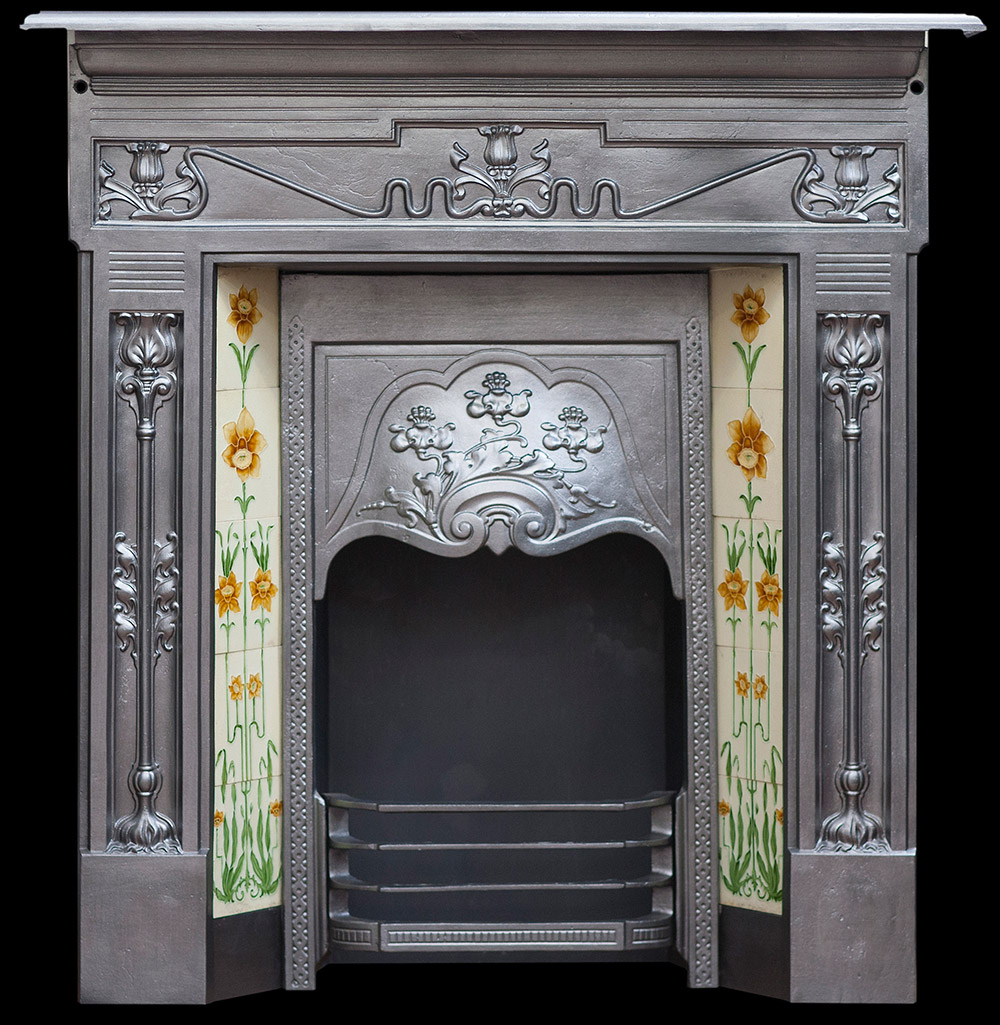
Incorporating Art Nouveau Fireplace Surrounds in Modern Homes
Integrating an Art Nouveau fireplace surround into a modern home can bring a touch of historical elegance and artistic beauty to contemporary interiors. These surrounds, with their intricate designs and high-quality craftsmanship, can serve as stunning focal points that enhance the overall aesthetic of a room. There are several considerations to keep in mind when incorporating Art Nouveau fireplace surrounds into modern homes.
One of the first considerations is the compatibility of the Art Nouveau design with the existing decor. While Art Nouveau is characterized by its ornate and organic forms, it can complement a variety of styles, including minimalist, eclectic, and traditional interiors. The key is to balance the intricate details of the fireplace surround with the overall simplicity or complexity of the room’s design.
Choosing the right location for an Art Nouveau fireplace surround is crucial. These pieces often serve as focal points, so placing them in a central and visible location can maximize their impact. Living rooms, dining rooms, and master bedrooms are ideal spaces for showcasing an Art Nouveau fireplace surround. Additionally, considering the room’s layout and ensuring there is adequate space for the surround is important for a harmonious integration.
The color scheme of the room should also be taken into account. Art Nouveau fireplace surrounds often feature-rich, earthy tones and natural motifs. Complementing these colors with a palette that includes soft greens, warm browns, and neutral shades can create a cohesive and inviting environment. Alternatively, contrasting the ornate surround with bold, modern colors can create a striking and dynamic look.
Incorporating complementary furnishings and decor can enhance the overall effect of an Art Nouveau fireplace surround. Furniture with curved lines, natural wood finishes, and botanical patterns can echo the design elements of the fireplace surround. Additionally, incorporating decorative accessories such as mirrors, vases, and lighting fixtures with Art Nouveau motifs can create a unified and stylish look.
Lighting is another important consideration. Proper lighting can highlight the intricate details and craftsmanship of an Art Nouveau fireplace surround. Using spotlights or wall sconces to illuminate the surround can enhance its visual impact and create a warm, inviting ambiance. Additionally, natural light can accentuate the beauty of materials like stained glass and ceramics, adding to the overall aesthetic.
Finally, maintaining the integrity and condition of an Art Nouveau fireplace surround is essential. Regular cleaning and proper care can preserve the beauty and functionality of the piece. Consulting with professionals who specialize in the restoration and maintenance of antique fireplaces can ensure that the surround remains a cherished and valuable feature of the home for years to come.

Maintaining and Restoring Art Nouveau Fireplace Surrounds
Maintaining and restoring Art Nouveau fireplace surrounds requires careful attention to detail and an understanding of the materials and techniques used in their construction. Proper maintenance and restoration can preserve the beauty and functionality of these pieces, ensuring they remain a cherished feature of the home for years to come.
Regular cleaning is essential for maintaining the appearance of an Art Nouveau fireplace surround. Dust and dirt can accumulate on the intricate carvings and decorative elements, dulling their appearance. Using a soft brush or cloth to gently remove dust can help keep the surround looking its best. For more thorough cleaning, mild soap and water can be used on wood and metal surfaces, while specialized cleaners may be required for ceramics and glass.
Protecting the fireplace surround from damage is also important. Avoiding the use of abrasive cleaning materials and harsh chemicals can prevent scratches and deterioration. Additionally, placing protective pads under heavy objects and using a hearth rug can help prevent damage from heat and sparks.
Restoration of Art Nouveau fireplace surrounds may be necessary if the piece has been damaged or has deteriorated over time. This process should be undertaken by professionals who have experience with antique and period fireplaces. Restoration can involve repairing or replacing damaged tiles, metalwork, and wood carvings, as well as refinishing surfaces to restore their original luster.
Preserving the original materials and craftsmanship is a key consideration during restoration. Whenever possible, original components should be repaired rather than replaced to maintain the historical integrity of the piece. If replacement is necessary, using materials and techniques that match the original design can help ensure a seamless and authentic restoration.
Regular inspection of the fireplace surround can help identify any issues that need attention. Checking for signs of wear, such as cracks, chips, or loose tiles, can allow for timely repairs that prevent further damage. Additionally, inspecting the fireplace itself, including the chimney and flue, can ensure safe and efficient operation.
Finally, consulting with experts who specialize in the maintenance and restoration of Art Nouveau fireplace surrounds can provide valuable guidance and assistance. These professionals can offer advice on the best cleaning products and techniques, as well as perform any necessary repairs or restorations. Their expertise can help ensure that the fireplace surround remains a beautiful and functional part of the home for generations to come.

Common Mistakes to Avoid
Neglecting Regular Maintenance
Neglecting regular maintenance is a common mistake that can lead to the deterioration of Art Nouveau fireplace surrounds. These pieces often feature intricate designs and delicate materials that require careful attention to preserve their beauty and functionality. Regular cleaning and inspection can prevent dust buildup, damage, and other issues that can compromise the integrity of the surround.
Using Inappropriate Cleaning Products
Using inappropriate cleaning products can cause significant damage to Art Nouveau fireplace surrounds. Harsh chemicals, abrasive materials, and excessive moisture can harm wood, metal, ceramics, and glass. It is important to use gentle, non-abrasive cleaners and to follow recommended guidelines for cleaning each type of material.
Improper Installation
Improper installation of an Art Nouveau fireplace surround can result in structural issues and reduced aesthetic appeal. Ensuring that the surround is properly fitted and securely attached to the wall is crucial for both safety and appearance. Professional installation can help avoid common pitfalls and ensure that the surround is installed correctly.
Ignoring the Design Context
Ignoring the design context of the room can result in a mismatched and disjointed appearance. Art Nouveau fireplace surrounds should complement the overall aesthetic of the space. Considering factors such as color scheme, furniture style, and architectural features can help create a cohesive and harmonious look.
Overlooking the Importance of Professional Restoration
Attempting DIY restoration without the necessary expertise can lead to irreversible damage to an Art Nouveau fireplace surround. Professional restoration is essential for addressing issues such as damaged tiles, worn metalwork, and deteriorating wood. Experts can ensure that the restoration is done with sensitivity to the original design and materials.
Failing to Address Structural Issues
Failing to address structural issues, such as a faulty chimney or damaged hearth, can compromise the safety and functionality of an Art Nouveau fireplace surround. Regular inspection and maintenance of the entire fireplace system, including the chimney and flue, are essential to ensure safe operation and prevent potential hazards.

What defines an Art Nouveau fireplace surround?
An Art Nouveau fireplace surround is defined by its distinctive characteristics, including organic forms, flowing lines, and natural motifs. These surrounds often feature intricate carvings, metalwork, and decorative tiles that reflect the movement’s emphasis on beauty and craftsmanship. The use of materials such as wood, metal, ceramics, and glass adds to the richness and complexity of the designs.
How do I maintain an Art Nouveau fireplace surround?
Maintaining an Art Nouveau fireplace surround involves regular cleaning, careful handling, and protection from damage. Using soft brushes or cloths to remove dust, avoiding abrasive cleaners, and periodically inspecting the surround for signs of wear are essential steps. Consulting with professionals for cleaning and restoration can also help preserve the piece’s beauty and integrity.
Can an Art Nouveau fireplace surround be incorporated into a modern home?
Yes, an Art Nouveau fireplace surround can be incorporated into a modern home. The key is to balance the ornate and organic design of the surround with the overall decor of the room. Complementary furnishings, a cohesive color scheme, and proper lighting can help integrate the surround into a contemporary interior, creating a unique and stylish focal point.
What materials are commonly used in Art Nouveau fireplace surrounds?
Common materials used in Art Nouveau fireplace surrounds include wood, metal, ceramics, and glass. Wood is often carved into intricate designs, while metals such as bronze and wrought iron are used for decorative elements. Ceramic tiles with floral and geometric patterns add color and texture, and stained glass panels can enhance the visual impact of the surround.
How do I find a professional for restoring an Art Nouveau fireplace surround?
Finding a professional for restoring an Art Nouveau fireplace surround involves researching and selecting experts who specialize in antique and period fireplaces. Recommendations from reputable sources, reviews, and portfolios of previous work can help identify qualified professionals. Consulting with preservation societies or organizations dedicated to historic restoration can also provide valuable referrals.

Related Images for Inspiration
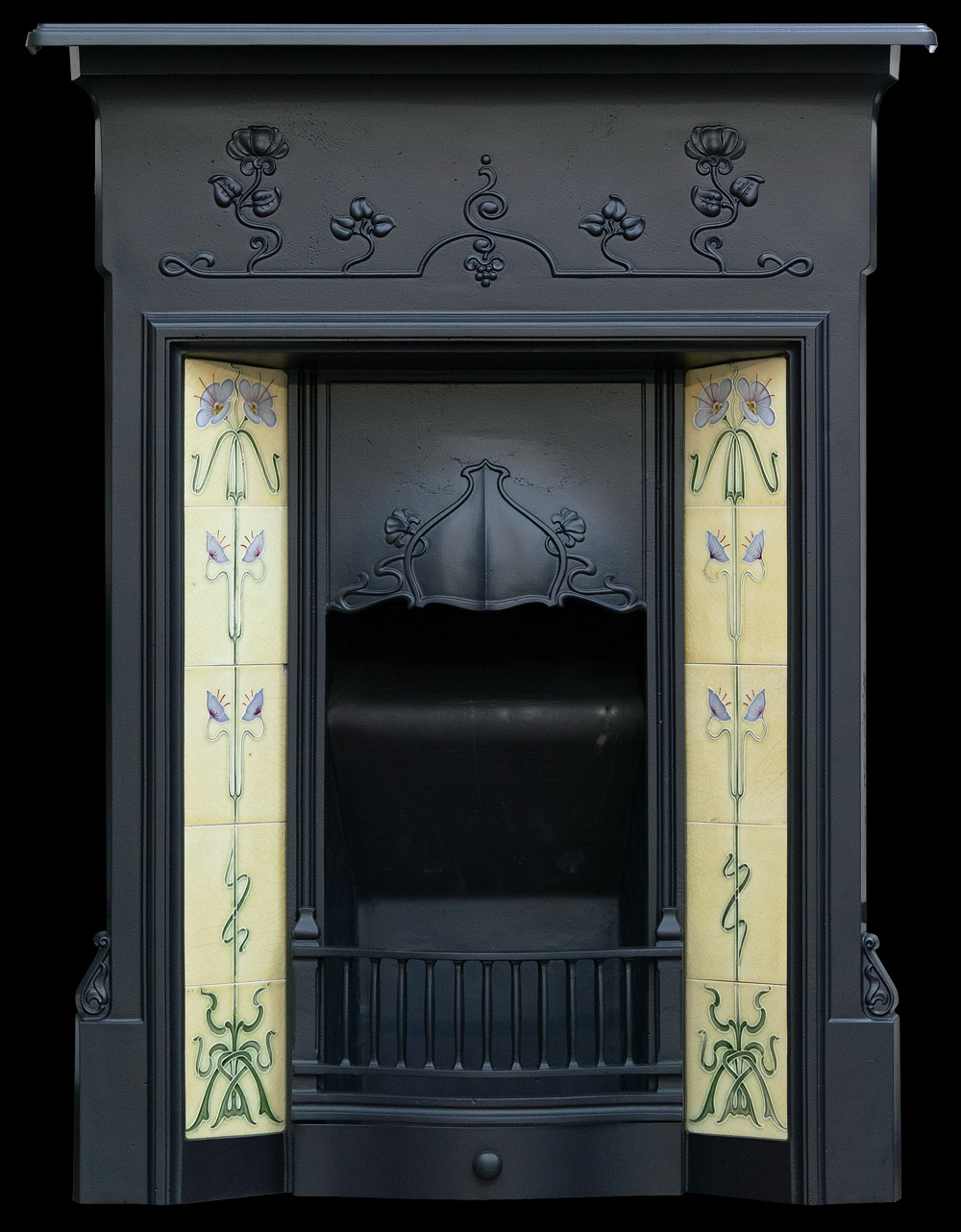
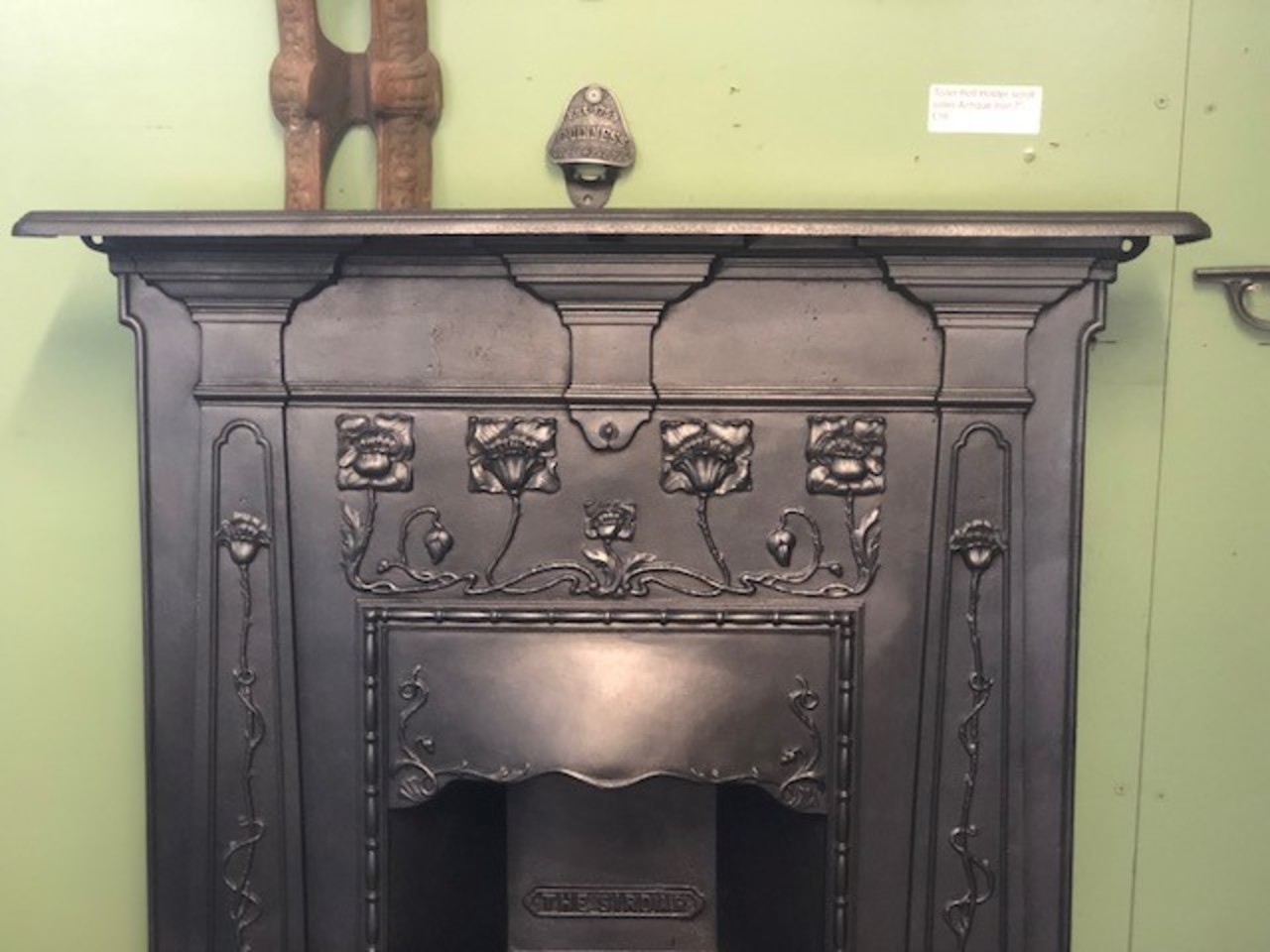
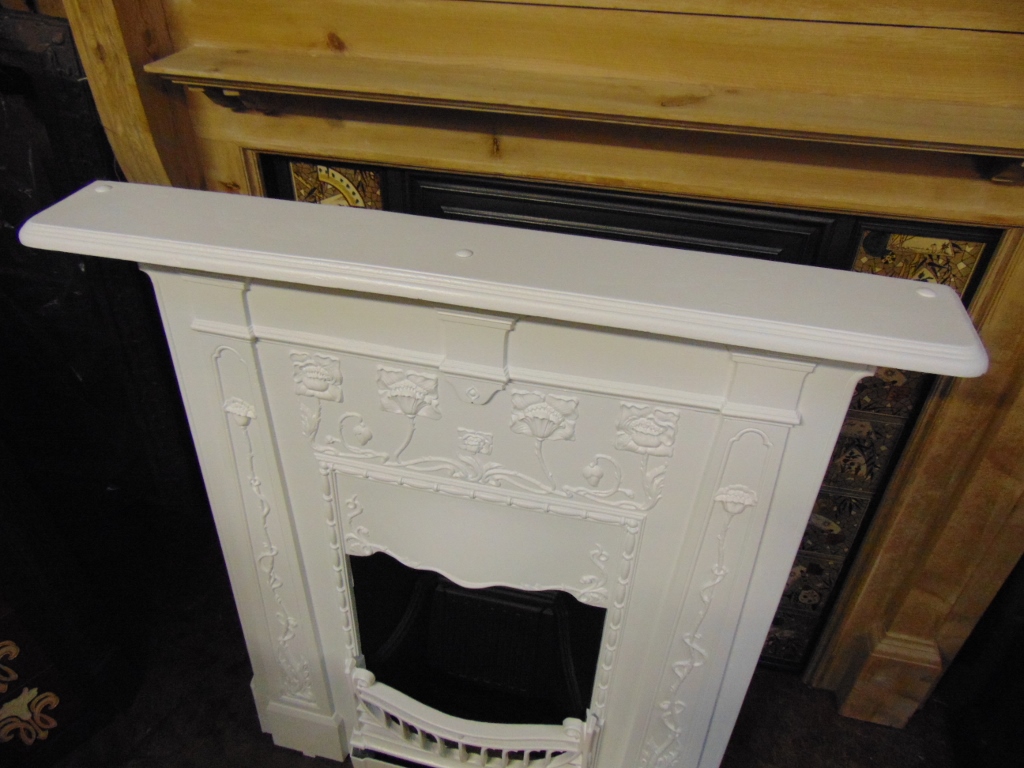
The fireplace surround, a testament to the Art Nouveau movement, was a symphony of swirling lines and organic forms. Its delicate, hand-wrought iron frame, adorned with stylized leaves and tendrils, cradled a mosaic of iridescent tiles depicting a fantastical underwater scene. The fireplace, a focal point in the grand drawing room, emanated warmth not only from the crackling fire but also from the artistry that breathed life into its every detail.
Related Posts:
- Pallet Fireplace Surround
- Craftsman Style Fireplace Surround
- Craftsman Fireplace Surround Designs
- Cultured Stone For Fireplace Surround
- Georgian Fireplace Surround
- Craftsman Style Fireplace Surround Ideas
- Rustic Fireplace Surround
- Art Nouveau Fireplace Surround
- Foam Fireplace Surround
- Fireplace Surrounds Derby